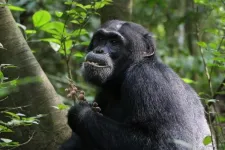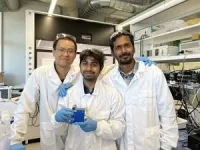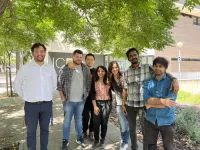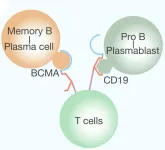(Press-News.org) Chimpanzees appear to consume plants with medicinal properties to treat their ailments, according to a study publishing on June 20 in the open-access journal PLOS ONE by Elodie Freymann from the University of Oxford, UK, and colleagues.
Many plants produce compounds that have medicinal effects on humans and other animals. Wild chimpanzees eat a variety of plant matter, including some that is nutritionally poor but may treat or lessen the symptoms of illness. However, it is hard to determine whether chimpanzees self-medicate, by intentionally seeking out plants with properties that help their specific ailments, or passively consume plants that happen to be medicinal.
The authors of the present study combined behavioral observations of wild chimpanzees (Pan troglodytes) with pharmacological testing of the potentially medicinal plants they eat. They monitored the behavior and health of 51 chimpanzees from two habituated communities in the Budongo Central Forest Reserve in Uganda. Next, they collected plant extracts from 13 species of trees and herbs in the reserve that they suspected the chimpanzees might be using to self-medicate, and tested them for their anti-inflammatory and antibiotic properties. These included plants that they observed sick or injured chimpanzees eating, but were not part of their normal diet, and plants that previous research has suggested chimpanzees might consume for their medicinal properties.
The researchers found that 88% of the plant extracts inhibited bacterial growth, while 33% had anti-inflammatory properties. Dead wood from a tree in the Dogbane family (Alstonia boonei) showed the strongest antibacterial activity and also had anti-inflammatory properties, suggesting that it could be used to treat wounds. Bark and resin from the East African mahogany tree (Khaya anthotheca) and leaves from a fern (Christella parasitica) exhibited potent anti-inflammatory effects. The researchers observed a male Chimpanzee with an injured hand seek out and eat leaves of the fern, which may have helped to reduce pain and swelling. They also recorded an individual with a parasitic infection consuming bark of the cat-thorn tree (Scutia myrtina).
The results suggest that chimpanzees seek out specific plants for their medicinal effects. The study is one of the first to provide both behavioral and pharmacological evidence of the medicinal benefits to wild chimpanzees of feeding on bark and dead wood. The medicinal plants growing in Budongo Central Forest Reserve could also be helpful for the development of new drugs to address the challenges of antibiotic resistant bacteria and chronic inflammatory diseases, the authors say.
The authors add: “In this paper, we demonstrate how watching and learning from our primate cousins may fast-track the discovery of novel medicines, while also emphasizing the importance of protecting our forest pharmacies.”
#####
In your coverage please use this URL to provide access to the freely available article in PLOS ONE: https://journals.plos.org/plosone/article?id=10.1371/journal.pone.0305219
Citation: Freymann E, Carvalho S, Garbe LA, Dwi Ghazhelia D, Hobaiter C, Huffman MA, et al. (2024) Pharmacological and behavioral investigation of putative self-medicative plants in Budongo chimpanzee diets. PLoS ONE 19(6): e0305219. https://doi.org/10.1371/journal.pone.0305219
Author Countries: UK, Portugal, Germany, Uganda, Japan, Czech Republic, Switzerland
Funding: Funding for this project was granted by the the Clarendon Fund at the University of Oxford (to EF), the British Institute of Eastern Africa (to EF), Keble College at the University of Oxford (to EF), Boise Trust Fund (to EF), German Federal Ministry of Education and Research (13FH026IX5, PI: L-AG and Co-I: FS) (to LAG, FS) and Neubrandenburg University of Applied Sciences (grant # 13310510) (to LAG, FS).
END
Wild chimpanzees seek out medicinal plants to treat illness and injuries
Sick chimpanzees eat tree bark, dead wood and ferns with antibiotic and anti-inflammatory effects
2024-06-20
ELSE PRESS RELEASES FROM THIS DATE:
New catalyst unveils the hidden power of water for green hydrogen generation
2024-06-20
Hydrogen is a promising chemical and energy vector to decarbonize our society. Unlike conventional fuels, hydrogen utilization as a fuel does not generate carbon dioxide in return. Unfortunately, today, most of the hydrogen that is produced in our society comes from methane, a fossil fuel. It does so in a process (methane reforming) that leads to substantial carbon dioxide emissions. Therefore, the production of green hydrogen requires scalable alternatives to this process.
Water electrolysis offers a path to generate green hydrogen which can be ...
Supermassive black hole appears to grow like a baby star
2024-06-20
Supermassive black holes pose unanswered questions for astronomers around the world, not least “How do they grow so big?” Now, an international team of astronomers, including researchers from Chalmers University of Technology in Sweden, has discovered a powerful rotating, magnetic wind that they believe is helping a galaxy’s central supermassive black hole to grow. The swirling wind, revealed with the help of the ALMA telescope in nearby galaxy ESO320-G030, suggests that similar processes are involved both in black hole growth and the birth of stars.
Most galaxies, including our own Milky Way have a supermassive black hole at their centre. How ...
Early detection crucial in bile duct cancer for patients with rare liver disease
2024-06-20
Primary sclerosing cholangitis (PSC) is a rare progressive liver disease that damages bile ducts and significantly increases the risk of bile duct cancer, particularly a type called cholangiocarcinoma (CCA). This cancer is aggressive, and curative surgery is uncommon. Liver transplantation is a potential treatment option for some PSC-CCA patients, especially if the cancer is caught early. Early diagnosis is essential for successful treatment.
PSC can affect people of all ages but primarily strikes men in their 30s and 40s. It is often accompanied by inflammatory bowel disease (IBD). The disease can progress to liver failure and increase the risk of colorectal cancer ...
BCMA-CD19 bispecific CAR-T therapy in refractory chronic inflammatory demyelinating polyneuropathy
2024-06-20
This study is led by Professor Junnian Zheng and Ming Shi from the Cancer Institute of Xuzhou Medical University, together with the team of Professor Guiyun Cui and Wei Zhang from the Affiliated Hospital of Xuzhou Medical University. The team reported for the first time using BCMA-CD19 bispecific CAR T cells for treating relapsed/refractory CIDP.
Chronic Inflammatory Demyelinating Polyneuropathy (CIDP) is an uncommon condition with sudden onset symptoms, including nerve damage affecting movement, sensation, speech, breathing, and heart rate. ...
Embryo and organoid models do not threaten the definition of personhood, bioethicist says
2024-06-20
Advances in organoids and embryonic models of human development have the potential to prompt social and existential questions—e.g., what defines human individuality? However, bioethicist Insoo Hyun of Harvard Medical School and the Museum of Science in Boston says that these models have the potential to strengthen rather than weaken the concept of human individuality when considered within the philosophical frameworks of “personhood” and sentience. In a commentary publishing June 20 in the journal Cell, Hyun argues that despite huge advances, we are a long way off from developing technologies that would ...
Great British Bake Off finalist Josh Smalley discusses the parallels between chemistry and baking
2024-06-20
Last year on a Friday evening, chemical biology researcher Josh Smalley was in the lab when he received a call inviting him to appear on the 14th and latest season of The Great British Bake Off. Starting as one of a group of 12 amateur bakers, Smalley made it all the way to the final round, where the top 3 contestants compete for the winning spot. In an essay published in the journal Cell Chemical Biology on June 20, Smalley describes the overlap between chemistry and baking and how his training in one ...
New genetic cause of obesity could help guide treatment
2024-06-20
Scientists have discovered a new cause of why people who lack a specific blood group are genetically predisposed to be overweight or obese.
A team of international researchers, led by the University of Exeter, discovered that people with a genetic variant that disables the SMIM1 gene have higher body weight because they expend less energy when at rest.
SMIM1 was only identified 10 years ago, whilst searching for the gene encoding a specific blood group, known as Vel. One in 5,000 people lack both copies of the gene, making them Vel-negative. The findings from the new research suggest that this group is also more likely to be overweight, a conclusion ...
Palaeontology: New, small, ancient crocodile-like reptile described in Brazil
2024-06-20
The discovery of a new, ancient, predatory reptile dubbed Parvosuchus aurelioi — part of a group of crocodile-like reptiles called pseudosuchians — in Brazil is described in a paper in Scientific Reports. The specimen, which dates to approximately 237 million years ago, during the Middle-Late Triassic, is the first small predatory reptile of its kind to be found in this country.
Prior to the dominance of the dinosaurs, pseudosuchians were a common form of ancient quadruped reptile during the Triassic Period (252 – 201 million years ago), with some species amongst ...
Prenatal maternal psychological distress during the pandemic and newborn brain development
2024-06-20
About The Study: The findings of this study suggest that increased maternal mental health symptoms during the COVID-19 pandemic are associated with subsequent changes in regional brain growth in newborn offspring.
Corresponding Author: To contact the corresponding author, Nickie Andescavage, M.D., email nniforat@childrensnational.org.
To access the embargoed study: Visit our For The Media website at this link https://media.jamanetwork.com/
(doi:10.1001/jamanetworkopen.2024.17924)
Editor’s Note: Please see the article for additional information, including ...
Healthy lifestyle and the likelihood of becoming a centenarian
2024-06-20
About The Study: In this case-control study of Chinese older adults, adhering to a healthy lifestyle appears to be important even at late ages, suggesting that constructing strategic plans to improve lifestyle behaviors among all older adults may play a key role in promoting healthy aging and longevity.
Corresponding Authors: To contact the corresponding authors, email Xiang Gao, M.D., Ph.D. (xiang_gao@fudan.edu.cn) and Xiaoming Shi, M.D., Ph.D. (shixm@chinacdc.cn).
To access the embargoed study: Visit our For The Media website at this link https://media.jamanetwork.com/
(doi:10.1001/jamanetworkopen.2024.17931)
Editor’s Note: Please see ...
LAST 30 PRESS RELEASES:
University of Oklahoma researcher awarded funding to pursue AI-powered material design
Exploring how the visual system recovers following injury
Support for parents with infants at pediatric check-ups leads to better reading and math skills in elementary school
Kids’ behavioral health is a growing share of family health costs
Day & night: Cancer disrupts the brain’s natural rhythm
COVID-19 vaccination significantly reduces risk to pregnant women and baby
The role of vaccination in maternal and perinatal outcomes associated with COVID-19 in pregnancy
Mayo Clinic smartwatch system helps parents shorten and defuse children's severe tantrums early
Behavioral health spending spikes to 40% of all children’s health expenditures, nearly doubling in a decade
Digital cognitive behavioral treatment for generalized anxiety disorder
Expenditures for pediatric behavioral health care over time and estimated family financial burden
Air conditioning in nursing homes and mortality during extreme heat
The Alps to lose a record number of glaciers in the next decade
What makes a good proton conductor?
New science reporting guide published for journalists in Bulgaria
New international study reveals major survival gaps among children with cancer
New science reporting guide published for journalists in Turkey
Scientists develop a smarter mRNA therapy that knows which cells to target
Neuroanatomy-informed brain–machine hybrid intelligence for robust acoustic target detection
Eight SwRI hydrogen projects funded by ENERGYWERX
The Lundquist Institute and its start-up company Vitalex Biosciences Announces Strategic Advancement of Second-Generation fungal Vaccine VXV-01 through Phase 1 Trials under $40 Million Competitive Con
Fine particles in pollution are associated with early signs of autoimmune disease
Review article | Towards a Global Ground-Based Earth Observatory (GGBEO): Leveraging existing systems and networks
Penn and UMich create world’s smallest programmable, autonomous robots
Cleveland researchers launch first major study to address ‘hidden performance killer’ in athletes
To connect across politics, try saying what you oppose
Modulating key interaction prevents virus from entering cells
Project explores barriers to NHS career progression facing international medical graduates
Jeonbuk National University researchers explore the impact of different seasonings on the flavor perception of Doenjang soup
Two Keck Medicine of USC Hospitals named Leapfrog Top Teaching Hospitals
[Press-News.org] Wild chimpanzees seek out medicinal plants to treat illness and injuriesSick chimpanzees eat tree bark, dead wood and ferns with antibiotic and anti-inflammatory effects







